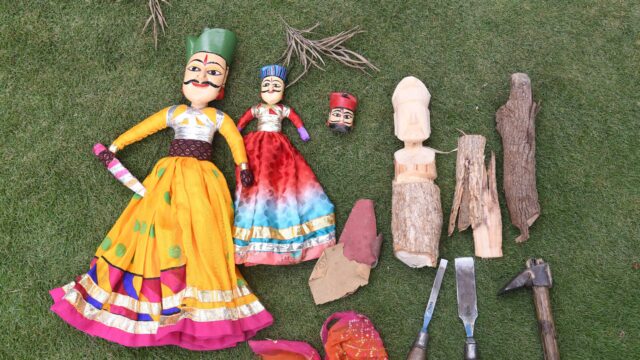Rajasthan, the puppetry centre of India, has spawned multiple versions of the origin story of this heart-warming practice. True to the character of the land, puppetry in Rajasthan is a down to earth and honest art form that portrays the vibrant colours of the state and its lilting music.

According to Dr Laique Hussain, director of the Bhartiya Lok Kala Mandal in Udaipur, there are two theories that try to trace the origins of puppetry in Rajasthan and both point to the probability that the art goes back many centuries in this region.

The first one is linked to Raja Vikramaditya while the second one is connected to Alauddin Khilji, the legendary king of Ujjain and his 32 singhasans that disappeared after his demise. It is believed that the 32 dolls that were part of the throne were puppets that used to narrate stories.

During the invasion of Rajasthan in the early 1300s, Khilji blockaded Nagore fort and cut off all the supply lines for food and other essentials, and was terribly angry when the king did not surrender even after six months. Curious to know the secret of their stubborn resistance, his spies discovered that the puppeteers or kathputliwalas were commissioned to narrate stories of Rajputana bravery to keep morales high inside the fortress. These stories often revolved around Rajput king Amar Singh.

These performers belonged to the Bhat community, which afterwards spread all over Rajasthan for their livelihood. They were often supported by the kings and royal patrons. Many of them would travel from one place to another to perform and lived a nomadic life. They were often treated to generous gifts of foodgrain and other items by local villagers since their performances were the only means of entertainment. Unfortunately, modern means of entertainment are forcing many traditional performers to switch to other occupations for their livelihood.

Significantly, in the olden days, local carpenters of Udaipur would craft Kathputlis for the Bhat community. Interestingly, the reference to Sutradhar of Natyashastra is extremely important in puppetry too. It means a person who controls the whole thing with sutra or thread.

Padma Shri Devilal Samar is considered the architect of modern puppetry in Rajasthan. He also popularised it beyond India’s borders. In 1952, he established Bhartiya Lok Kala Mandal to educate and promote the folk art of Rajasthan. Influenced by other schools of international puppetry, he introduced more strings for better movement of the puppet’s limbs and other body parts. Conventional Rajasthan Kathputli only consisted of movement of the upper part of the puppet’s body (since the design did not call for legs) and a limited number of strings to allow for all movement to be controlled with two hands.

Currently, many puppeteers work and perform in hotels and restaurants. Prakash Bhat and his brother Jeetu Bhat, originally from the Nagore district, work with a hotel in Mount Abu and conduct regular performances for the guests.

“I used to travel with my father all around the year to perform in villages. People would show great interest and respect for the art. They would treat us to good food and gift us with clothes if they were pleased with our performance,” recalls Prakash.

He feels the art will get a boost if more entrepreneurs hire them to perform for visitors. “If we get more business we can afford to sell more puppets that will help us financially as well as encourage us to continue with our tradition.” says Prakash.
Must Visit:
- Bhartiya Lok Kala Mandal, Museum and Puppet and Folk Dance show Panchawati, Chetak Circle, Udaipur 0294 252 9296
Tickets: INR 60-260
For details https://www.lokkalamandal.com




